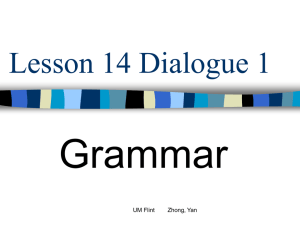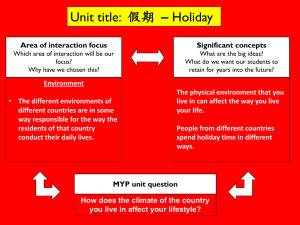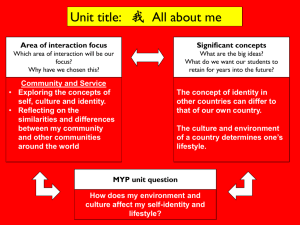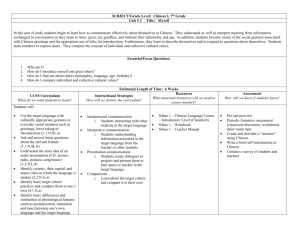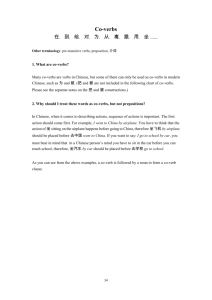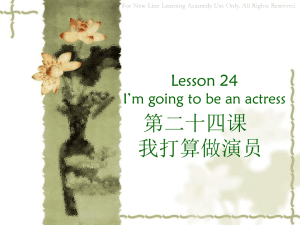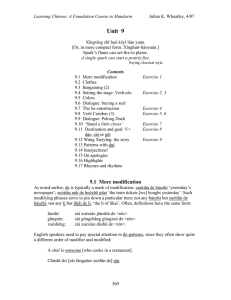9.4 Setting the stage: Verb-zhe ( ; often
advertisement
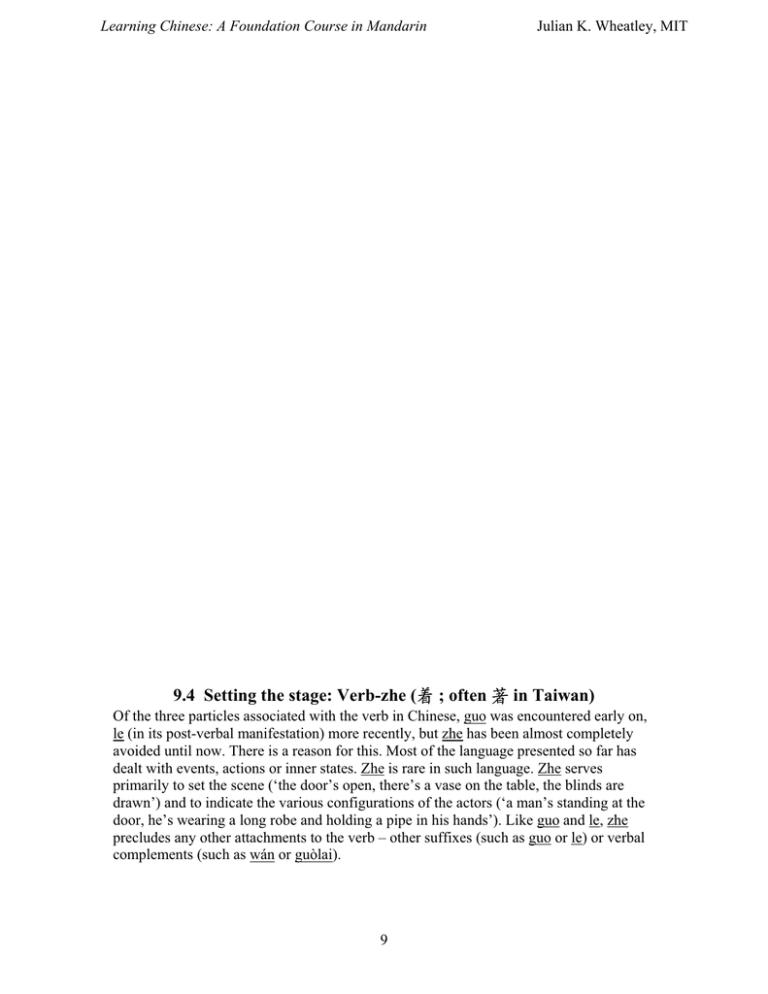
Learning Chinese: A Foundation Course in Mandarin Julian K. Wheatley, MIT 9.4 Setting the stage: Verb-zhe (ᓹ ; often ᓎ in Taiwan) Of the three particles associated with the verb in Chinese, guo was encountered early on, le (in its post-verbal manifestation) more recently, but zhe has been almost completely avoided until now. There is a reason for this. Most of the language presented so far has dealt with events, actions or inner states. Zhe is rare in such language. Zhe serves primarily to set the scene (‘the door’s open, there’s a vase on the table, the blinds are drawn’) and to indicate the various configurations of the actors (‘a man’s standing at the door, he’s wearing a long robe and holding a pipe in his hands’). Like guo and le, zhe precludes any other attachments to the verb – other suffixes (such as guo or le) or verbal complements (such as wán or guòlai). 9 Learning Chinese: A Foundation Course in Mandarin Julian K. Wheatley, MIT 9.4.1 Verbs involving configuration or bodily attitudes Zhàn and zuò and the words listed below are examples of verbs that involve attitudes or configurations of the body that are compatible with the persisting state interpretation and therefore particularly susceptible to the zhe suffix. zhàn zuò tӽng shuì<jiào> dnjn stand sit lie sleep squat; wait crouch dČng dƯng lèng watch stare intently blankly Examples TƗ zài dìbӽn shàng shuì-zhe ne. He’s asleep on the floor. TƗ zài shƗfa shàng tӽng-zhe ne. She was lying on the sofa. TƗmen zài ménkǂu dČng-zhe nƱ ne. They’re waiting for you at the door. Bié lèng-zhe. Lái bƗng wǂ ná! DuìbuqƱ, wǂ lèi+de bùdeliăo. Don’t just stare; give me a hand. Sorry, I’m exhausted. Dàbiàn, zuò-zhe bùrú dnjn-zhe shnjfu! Wǂ tóngyì. With #2, sitting isn’t as comfortable as squatting. I agree. Standing or sitting in class? The act of standing up can be expressed as zhànqƱlai; the act of sitting down, as zuòxià – both making use of directional complements (comparable to English ‘up’ and ‘down’). However, once the acts have been performed, the resulting states are ‘standing’ and ‘sitting’, respectively: zhàn-zhe and zuò-zhe: Kuài yào shàngkè de shíhou lăoshƯ gƝn nƱmen shuǀ shénme ne? TƗ shuǀ “Shàngkè.” NƱmen jiu zhànqƱlai gƝn tƗ shuǀ: “LăoshƯ, hăo.” Ránhòu ne? NƱmen dČi zhàn-zhe, duì ba? Zuò-zhe tài shnjfu le, rúguǂ nƱmen yԁu yìdiănr lèi de huà, hƟn kuài jiu huì shuìzháo de. Zhàn-zhe shuǀ wàiyǎ gèng hăo. DƗng nƱmen liànxí duìhuà de shíhou, lăoshƯ jƯngcháng shuǀ: “Zhàn-zhe kƟyƱ, zuò-zhe yƟ kƟyƱ.” Zhè shíhou nƱmen cái kƟyƱ zuòxià. Dànshi rúguǂ nƱmen bànyӽn de shi fúwùyuán de huà, nà nƱmen zuì hăo zhàn-zhe. Zài Zhǀngguó, fúwùyuán shi bù gƝn kèrén zuò zài yìqƱ! Notes: ránhòu ‘afterwards’ dàduǀshù ‘the majority’ dƗng…de shíhou ‘when’ liànxí ‘practice’ duìhuà ‘dialogues’ bànyӽn ‘take the role of’; act’ huì…de ‘will [in predications]’ 10 Learning Chinese: A Foundation Course in Mandarin Julian K. Wheatley, MIT Verbs of wearing (chuƗn, dài ‘wear [accessories]’, jì [ties]) and holding (ná ‘carry; hold’, dài ‘lead; bring’) also commonly appear with zhe: TƗ jƯntiƗn chuƗn-zhe yí jiàn hóng dàyƯ ne. Today she’s wearing a red coat. TƗ tóu shàng dài-zhe yì dӿng qíguài She was wearing a curious hat on [her] head. de màozi. NƱ shԁu lƱ ná-zhe de shi shénme? Yì bƗo kǂuxiƗngtáng! What are you holding in your hands? A pack of bubble gum. NƱ kàn, tƗ shԁu lƱ ná-zhe qiƗng. NƱ fàngxƯn ba. Shoshù mínz· hƟn xƱhuan dliè. Look, he’s got a gun. Don’t worry! Minority people love to hunt! 9.4.2 Doors and windows In addition to the configurations of people, the arrangement of furnishings and other objects in a room can also be presented with V-zhe. Ns yӿzi zhuǀzi chair table Vs guà hang fàng put huà<r> picture dƝng light bӽi arrange; display huƗpíng vase chuƗnghu window qiáng wall suԁ lock guƗn close; shut kƗi open a) Item V-zhe Mén kƗi-zhe <ne>. Mén kƗi-zhe – kČy. The door’s open. It’s okay open. DƝng kƗi-zhe ne. Qng b tƗ guƗnshàng. The light’s on. Please switch it off. ChuƗnghu guƗn-zhe ne. Méi guƗnxi, tài lČng le. The window’s closed. Never mind, it’s too cold [to have it open]. Mén suԁ-zhe ne. Jìnbuqù. W΅ y΅u yàoshi. The door’s locked. Can’t get in. I have a key. 11 Learning Chinese: A Foundation Course in Mandarin Julian K. Wheatley, MIT b) Existance: Location V-zhe item V-zhe can also provide a more precise substitute for yԁu in the existence pattern: LOC’N yԁu ITEM > LOC’N V-zhe ITEM ChuƗnghu pángbiƗnr yԁu yì zhƗng zhuǀzi. There’s a table next to the window. ChuƗnghu pángbiƗnr fàng-zhe yì zhƗng zhuǀzi. There’s a table standing next to the window. (ie ‘placed there and remaining’) > English often uses the verbs ‘stand’ or ‘sit’ in such contexts, extending terms that are otherwise only applied to humans to physical objects. Chinese does not do this: Zhuǀzi shàng fàng-zhe yí ge huƗpíng. There was a vase sitting on the table. Other examples: Zhuǀzi shàng bӽi-zhe jӿ zhƗng míngpiàn. A number of business cards were arranged on the table. Qiáng shàng guà-zhe yì fú huàr. Hanging on the wall was a painting. ShƗfa shàng zuò-zhe yí ge jӿngchá. A policeman was sitting on the sofa. Zhuǀzi dӿxia shuì-zhe yí ge xiӽo wáwa. A baby was sleeping under the table. c) Location: Person Location V-zhe <ne>. The location pattern with zài also has its correlate with V-zhe: TƗ zài chuáng shàng zuò-zhe ne. They are/were sitting on the bed. TƗmen zài shƗfa shàng shuì-zhe ne. They’re sleeping on the sofa. Kèren zài ménkǂu dČng-zhe nƱ ne. [Your] guest’s waiting for you at the door. d) V-zhe V Zhe frequently accompanies the first of two verbs. In such cases, V-zhe provides the setting, or context, for the second verb: TƗ ná-zhe huà huíjiƗ le. She went home, holding the painting. Bù yƯnggƗi dƯ-zhe tóu zԁulù! You shouldn’t walk with your head down. 12 Learning Chinese: A Foundation Course in Mandarin Julian K. Wheatley, MIT TƗ xiào-zhe shuǀ: She laughed and said: Wԁ méi shíjiƗn gƝn nӿ cƗi-zhe wánr. I don’t have time to play guessing games with you. (‘guess-ing have fun’) Notes a) dƯ ‘to lower’; contrast dӿxià ‘under; underneath’. b) xiào ‘laugh; smile’; cf. xiàohuà ‘a joke’; kƗi wánxiào ‘be kidding’. c) cƗi ‘guess’; cƗiduì ‘guess right’ and cƗicuò‘guess wrong’; cƗibuchnj ‘cannot guess’ e) V-zhe in imperatives Zhe can also appear in imperatives: Nӿ liú-zhe ba. Ná-zhe ba. DČng-zhe ba. TƯng-zhe – bié zài shuǀ le! You take [it]. (‘keep-persist’) Hold [it], please. (‘hold persist’) Hang on. Listen – don’t say any more! f) Negation There seems to be relatively little need to report the negation of a persistent state. But where it occurs, it is formed with méi<you>, (usually) without zhe: Mén shì bu shì kƗi-zhe ne? Méi kƗi, guƗn-zhe de. Is the door open? It isn’t open, it’s closed. QƱngwèn, jӿ diӽn? DuìbuqƱ, wǂ jƯntiƗn méi dài biăo. What’s the time, please? Sorry, I’m not wearing my watch today. Exercise 2 a) Provide English paraphrases: 1. Zhàn-zhe gànmá? Zuòxià ba. / Wǂ zhàn-zhe bӿ zuò-zhe shnjfu. 2. NƱ kàn, Wèi lăoshƯ shԁu shàng dài-zhe yí ge dà jƯn biăo, shƝn shàng chuƗn-zhe yí jiàn pídàyƯ. / Duì, tƗ gƗng zhòng-le yí ge dàjiӽng! 3. Xuéxiào de dàménkԁu xiƟ-zhe ‘Hӽohӽo xuéxí, tiƗntiƗn xiàng shàng.’ NƱ kuài chnjqù kànkan, mén wàitou zhàn-zhe yí ge lӽowài, shuǀ shi yào zhӽo nƱ. 4. 5. Wàitou xià-zhe xuČ, kƟshì yìdiănr dǀu bù lČng! biăo gƗng zhòngjiӽng N ‘watch’ xuČ ADV ‘just; a short while ago’ xuéxiào VO ‘win a lottery; hit the jackpot (hit-prize) 13 N ‘snow’ N ‘school’ Learning Chinese: A Foundation Course in Mandarin Julian K. Wheatley, MIT b) Provide Chinese praphrases: 1. When we got there, there were already people waiting for us in front of the door. 2. “The door’s open, you can go on in,” I said. 3. “The door’s locked, we can’t get in,” they said. 3. Don’t stand; the people sitting in the back can’t see. There are seats in front still. 4. There was a table by the door with several bottles of soda arranged on it. 5. On the wall above the table was a sign (páizi) with characters written on it. ________________________________________________________________________ 9.4.3 Ongoing acts versus persisting states First impressions tend to associate V-zhe with English V-ing: zhànzhe ‘standing’; zuòzhe ‘sitting’. However, while it is true that many cases of V-zhe do correspond to V-ing in English, the reverse is not true: many cases of V-ing do not correspond to V-zhe. The reason for this is that English uses V-ing for both ongoing acts, and for the ongoing states that result: She’s standing up right now. TƗ zhèng zài zhànqӿlai ne. [act] She’s not moving, she’s just standing there. TƗ bú dòng, jiu zài nàr zhàn-zhe ne. [state] Zhèng zài supports the directional complement, qӿlai, to underscore the fact that the action is happening before our eyes – it’s ongoing; while the presence of zhe after zhàn indicates that the standing is persistent. While both are in a sense ongoing, Chinese distinguishes them as ongoing act versus persisting state. Recall that ongoing or recent actions are often explicitly marked by zài placed in the adverbial position right before the verb: TƗmen hái zài xӿzӽo ne. Nӿ zuìjìn zài zuò shénme? TƗmen tiƗntiƗn zài xuéxí Zhǀngwén. They’re still bathing. What have you been doing lately? They’ve been studying Chinese daily. To emphasize how current the action is, the ADV zhèng ‘exact’ can be placed before zài: TƗ zhèng zài chƯfàn ne. YìhuƱr gƟi nƱ dӽguoqu, xíng ma? Xíng, bù jí, bù jí. She’s eating right now. Can she phone you [back] in a short while? Sure, no hurry. Wԁ zhèng zài xӿzӽo de shíhou, jӿngchá gČi wԁ dӽ le ge diànhuà. TƗmen gƝn n shuǀ shénme? The police phoned me just as I was having a bath. What did they want? TƗ zhèng zài gƝn tƗ shuǀhuà ne. TƗmen zài shuǀ xiƝ shénme? She’s talking to him right now. What are they talking about? 14 Learning Chinese: A Foundation Course in Mandarin Julian K. Wheatley, MIT In fact, for some northern speakers, the pattern can be further reinforced by a following zhe – along with final ne: Zhèng zài xià-zhe yԃ ne. ZƗogƗo, w΅ de sn wàng zài jiƗ l le. It’s raining right now! Drat, I’ve left my umbrella at home! The fact that zài may co-occur with zhe may seem strange, since in the last section, V-zhe was viewed in contrast to the zai-V pattern. But apparently, in some cases the two notions of ongoing and persisting can complement one another. The range of the V-ing form in English (the so-called progressive tense) – which includes ongoing actions (putting on) and persistent states (wearing) – is, after all, a precedent for associating the two notions. 9.4.4 Perspectives Notice that some situations can be interpreted as ongoing actions or persistent states: TƗ zhèng zài shuìjiào ne. TƗ shuì-zhe ne. She’s just going to bed. She’s asleep. [action] [state] TƗ zài dƟng chƝ. TƗ dČng-zhe ne. He’s waiting for a bus. He’s waiting. [action] [state] TƗmen zài chƯfàn ne. TƗmen yíkuàir chƯ-zhe fàn ne. They’re eating. They’re having a meal. [action] [state] TƗmen dǀu zài tiàowǎ. Péngyou chàng-zhe, tiào-zhe, gƗoxìng-jíle! They’re all dancing. [action] The friends are extremely [state] happy, singing and dancing. TƗ zhèng zài chuƗn dàyƯ ne. TƗ chuƗn-zhe dàyƯ ne. She’s putting on her coat right now. She’s wearing a coat. [state] TƗ zài ná qiƗng. TƗ shԁu lƱ názhe yì zhƯ qiƗng. He’s picking up a gun. He’s holding a gun. [action] [state] TƗ zài bӽ shnj fàng zài hézi lƱ. He’s putting the books in a box. There are lots of books sitting in the box. [action] Hézi lƱ fàng-zhe hƟn duǀ shnj. 15 [action] [state] Learning Chinese: A Foundation Course in Mandarin Julian K. Wheatley, MIT Exercise 3 Paraphrase in Chinese: 1. The soup’s hot. / The soups heating up. / The soup’s heated. 2. She’s closing the door. / She closed the door. / The door’s closed. 3. He’s putting on his shoes. / He was wearing sandals (tuǀxié). / He put on his shoes. 4. I’m just in the process of finishing up my report (bàogào). 5. She’s in the bath right now; can you come back in 20 minutes? ____________________________________________________________________ 9.4.5 At the temple Lăo Wèi is visiting the Qìngfúgǀng in the Chinese quarter of Rangoon (YángguƗng), Burma (Myanmar). Qìngfúgǀng means, literally, ‘palace celebrating good fortune’. In China and Southeast Asia, temples are often considered palaces of the gods, hence the use of the term gǀng ‘palace’ in the name. [Snj xiƗnshƝng is based on a real person, a Sino-Burmese whose ancestors emigrated to Burma by way of Singapore early in the 20th century. Typical of Sino-Burmese, he speaks Hokkien (Mӿnnányԃ), Burmese (Miӽndiànyԃ), as well as some Mandarin.] Wèi Snj xiƗnsheng, zhè shi Qìngfúgǀng – gǀngdiàn de gǀng, duì ma? Wèishénme jiào gǀng? Mr. Su, this is Qingfu Gong – the gong of ‘palace’, right? How come it’s called a ‘palace’? Snj Zài Dǀngnányà, gǀng yČ shi sìmiào de yìsi. . Nà, zhèi ge sìmiào hƟn yԁu yìsi. Nӿ kàn, ménshàng de ménshén – zhƝn wƝiwԃ! In Southeast Asia, ‘palace’ also means ‘temple’. Well, this temple is interesting. Look at the door guardians on the door – they’re quite impressive! Snj Zhè shi YángguƗng zuì lăo de sìmiào, 1898 nián jiànlì de. This is Rangoon’s oldest temple; it was established in 1898. Wèi Snj xiƗnshƝng, qƱngwèn, zhè shi shénme shén? Mr. Su, can I ask you what god this is? Snj GuƗn Dì; huòzhƟ GuƗn Loye. BƟnlái shi ge jiƗngjun, shi SƗnguó shídài de yƯngxióng. Sdiào yƱhòu chéng-le ge shén. It’s Guan Di; or ‘Lord’ Guan. He was originally a general, a hero from the time of the 3 Kingdoms. After he died, he became a ‘god’. Wèi NƱ zƟnme zhƯdao shi GuƗn Dì. How do you know it’s Guan Di? Wèi 16 Learning Chinese: A Foundation Course in Mandarin Julian K. Wheatley, MIT Snj NƱ kàn, gèzi hƟn gƗo, y΅u cháng húzi, hóng liăn, tóu shàng dài-zhe <yí> ge tèsè de màozi, sh΅u lƱ ná-zhe yì bƟn shnj. Look, he’s tall, has a long beard, a red face, he’s got a special hat on his head, and a book in his hand. Wèi Liăn hƟn kČpà. TƗ shԁu lƱ ná-zhe de shi shénme shnj ne? What a frightening face! What’s the book he’s holding? Snj Hӽoxiàng shi Kԁngfnjzӿ de Chnjnqinj. Looks like it’s Confucius’ Spring and Autumn Annals. Guan Di is learned as well. GuƗn Dì yƟ shi yԁu xuéwen de. Notes a) Qìngfúgǀng ‘The temple of blessed happiness’. b) sìmiào Generic wod for ‘temple’. c) shén ‘god; divinity’; shén are usually deified historical figures whose spiritual power can be called on for protection or assistance. GuƗn Dì was GuƗn Yԃ, the third of the heroes who swore brotherhood in the famous ‘peach garden oath’ that opens SƗnguó Yӽnyì ‘The Romance of the Three Kingdoms’. He has many other names, including GuƗn Lӽoye ‘Grandpa Guan’ – which in this context is probably better translated ‘Lord Guan’. d) yƯngxióng ‘hero’ – also the name of a ZhƗng Yìmóu’s film. e) sӿdiào ‘die-fall’ = sӿ le ‘died’. f) chéng ‘become’ g) húzi ‘beard’ h) tèsè N ‘special, unusual qualities’, ie ‘a hat of an unusual type’; the tè of tèbié and the sè of yánsè. Tèsè is a N, not a SV. i) kČpà ‘frightening (able-fear)’; cf. kČ’ài. j) Chnjnqinj ‘The Spring and Autumn Annals (spring-autumn)’, a chronicle of the State of Lԃ (that covered parts of modern ShƗndǀng) from 722-481 BC. It is considered to have been edited by Confucius in such a way as to illustrate his political philosophy. k) yԁu xuéwen de ‘one who has ~ shows learning, scholarship’ (of a person, or a work). 17 Learning Chinese: A Foundation Course in Mandarin Julian K. Wheatley, MIT Gods of Literature and War at the Man-Mo (Wén Wԃ) Temple, Hong Kong 9.5 Colors The Chinese core color terms are the following: hóng red zӿ purple; violet huáng yellow lԋ lán green blue hƝi bái black white QƯng, a term that was applied to dark greens, blues and some browns – the colors of earth and sky – in earlier Chinese, appears in certain phrases, such as qƯngcài ‘green vegetables’ or qƯngshƗn-lԋshuӿ ‘green mountains and blue waters’ (a standard description for lush scenery). When used to modify a noun, color terms are often suffixed with sè, from yánsè ‘color’: huángsè de hóngsè de zӿsè de lԋsè de lánsè de Secondary color terms have been formed by extending the meaning of words from other semantic domains, eg ‘grey’ from ‘ash’: huƯsè de ashes > grey kƗfƝisè de coffee > dark brown zǀngsè de palm > brown chéngsè de orange > orange Not surprisingly, colors have rich cultural associations in China. Traditionally, red (the color of blood) is considered festive and auspicious, and for that reason, was adopted by the Communist Party. Doorway scrolls (duìlián) are written on red paper; presents are often wrapped in it. Charms (symbols on paper, sold in temples) were generally written 18 Learning Chinese: A Foundation Course in Mandarin Julian K. Wheatley, MIT on yellow paper. Only the emperor could wear yellow. White was associated with funerals. Examples: hóng yƯfu hóngsè de yƯfu red clothes lán xiézi lánsè de xiézi blue shoes hƝi màozi hƝisè de màozi black hats Usage Xiànzài zài Zhǀngguó shénme yánsè de chƝ zuì liúxíng? What color cars are most popular in China these days? ChuƗn hƝisè de yƯfu hČn kù! It’s cool to wear black clothes! ChuƗn huángsè de T-xù de nèi wèi shi shuí [shéi]? Who’s that wearing the yellow T? Jì hóngsè de lӿngdài de shi JiƗng Zémín. The person in the red tie is JiƗng Zémín. Nӿ kàn, tƗ chuƗn hóng xié, tài qíguài le! Look, he’s wearing red shoes, [that]’s too weird! 19 MIT OpenCourseWare http://ocw.mit.edu 21G.103 Chinese III (Regular) Fall 2005 For information about citing these materials or our Terms of Use, visit: http://ocw.mit.edu/terms.
